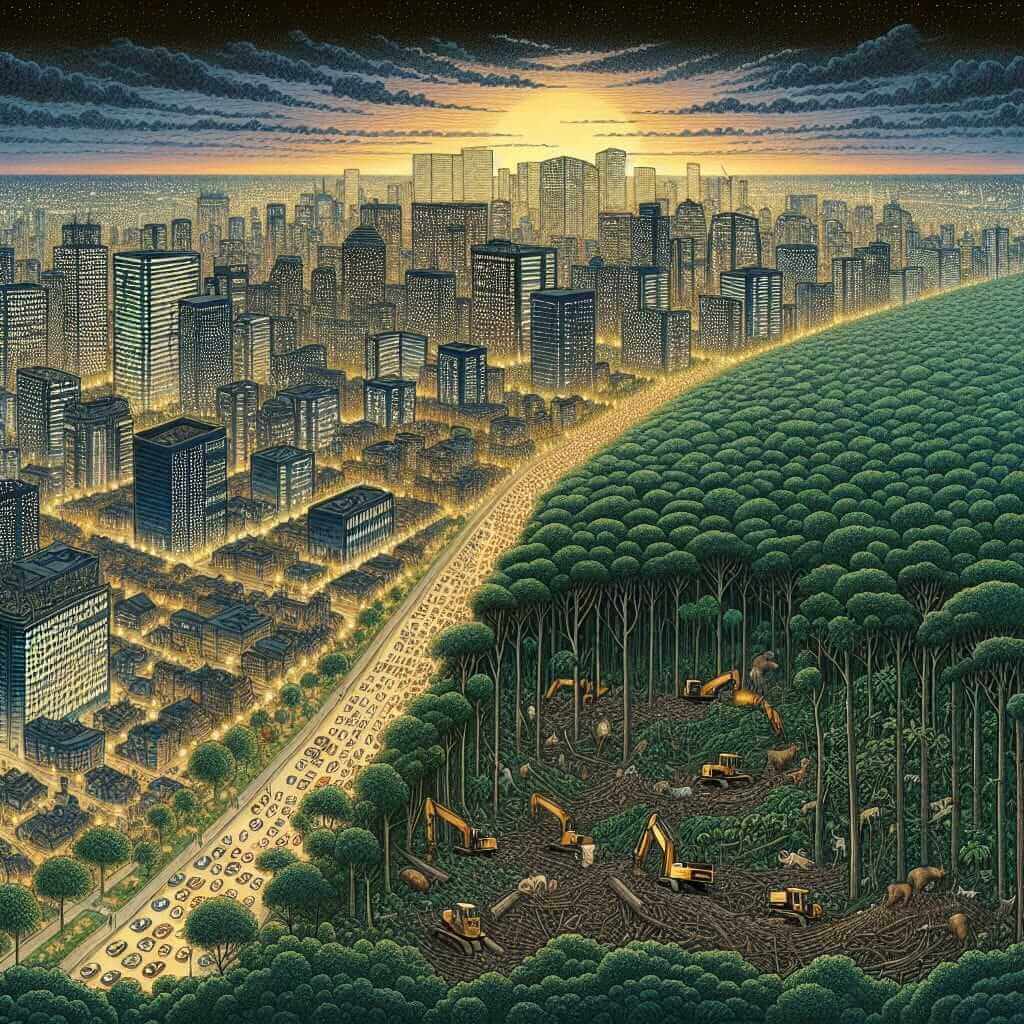Understanding the profound impact urbanization has on wildlife habitats is crucial for those preparing for the IELTS Reading test. This article not only covers this important topic but also provides a detailed IELTS Reading task with questions and answers, allowing you to practice and perfect your skills.
Introduction
The IELTS Reading section assesses your ability to read and understand different types of texts. One frequently covered topic is the impact of urbanization on wildlife habitats. This subject is both timely and commonly appearing in IELTS examinations, reflecting current global issues and trends.
Urbanization, a growing phenomenon worldwide, significantly affects wildlife habitats. This topic’s relevance means it could very well appear in your IELTS Reading test. Let’s dive into an IELTS Reading passage on this topic and explore the kinds of questions you might face.
IELTS Reading Passage: The Impact of Urbanization on Wildlife Habitats
Passage
Urbanization is expanding rapidly, encroaching on natural habitats globally. This trend poses a significant threat to wildlife, altering ecosystems and diminishing biodiversity. As cities grow, natural landscapes are transformed into urban areas, leading to habitat loss, fragmentation, and degradation.
Fragmentation occurs when large habitats are divided into smaller, isolated patches. This isolation can inhibit wildlife movement, reduce genetic diversity, and increase species vulnerability to environmental changes. Furthermore, urban environments introduce pollution, noise, and artificial lighting, which can disrupt natural behaviors and physiological processes in animals.
Moreover, urbanization can lead to the introduction of invasive species that outcompete local flora and fauna, further endangering native species. Human activities, such as deforestation and land conversion for agriculture and infrastructure, exacerbate these impacts, leading to a decline in habitat quality and availability.
Conservation efforts are essential to mitigate these effects. Strategies include creating green corridors to connect fragmented habitats, implementing urban planning that prioritizes ecological sustainability, and promoting biodiversity through the preservation of green spaces within urban areas.
Understanding the balance between urban development and environmental preservation remains critical. Sustainable practices and proactive conservation measures can help protect wildlife habitats while accommodating human development needs.
Practice Questions
Based on the above passage, here are different types of IELTS Reading questions:
Multiple Choice
-
What is a significant consequence of urbanization on wildlife habitats?
a. Increased biodiversity
b. Habitat fragmentation
c. Improved habitat connectivity
d. Enhanced wildlife protection -
How does habitat fragmentation affect wildlife?
a. Increases genetic diversity
b. Facilitates wildlife movement
c. Conducts gene flow across populations
d. Reduces genetic diversity and increases species vulnerability
True/False/Not Given
- Urbanization has no impact on animal behaviors. (False)
- Defragmentation helps to reduce pollution in urban areas. (Not Given)
- Creating green corridors is a strategy mentioned to mitigate habitat fragmentation. (True)
Matching Headings
Match the following headings with the appropriate paragraphs:
a. The Role of Conservation Efforts
b. The Process and Effects of Habitat Fragmentation
c. The Introduction of Invasive Species
Answer Key
Multiple Choice
- b. Habitat fragmentation
- d. Reduces genetic diversity and increases species vulnerability
True/False/Not Given
- False
- Not Given
- True
Matching Headings
- Paragraph 1: b. The Process and Effects of Habitat Fragmentation
- Paragraph 2: c. The Introduction of Invasive Species
- Paragraph 3: a. The Role of Conservation Efforts
Common Mistakes
When dealing with passages such as the above, students often misinterpret the given information or fail to locate the answers in the text. It’s essential to read each question carefully and refer back to the passage to ensure comprehension and accuracy.
Vocabulary
Here are some challenging words from the passage:
- Encroaching (verb): /ɪnˈkroʊtʃɪŋ/ – Intruding on (a person’s territory or rights).
- Fragmentation (noun): /ˌfræɡmənˈteɪʃən/ – The process or state of breaking or being broken into small or separate parts.
- Invasive species (noun): /ɪnˈveɪsɪv ˈspiːʃiːz/ – Non-native species that spread widely and cause harm to other species and ecosystems.
Grammar Highlight
In this passage, notice the use of:
Passive Voice: “Urbanization is expanding rapidly,” “Natural landscapes are transformed.”
Reduced Relative Clauses: “Leading to habitat loss” (instead of “which leads to habitat loss”).
Example Sentences
- Passive voice: “The city was designed to be eco-friendly.”
- Reduced relative clause: “The policies implemented helped to reduce pollution.”
Tips for High IELTS Reading Scores
- Practice Regularly: Consistent practice helps improve reading speed and comprehension.
- Expand Vocabulary: A broad vocabulary aids in understanding complex texts.
- Familiarize with Question Types: Understand different IELTS question types and practice accordingly.
- Time Management: Practice under timed conditions to enhance speed and efficiency.
By focusing on these strategies, you can considerably improve your performance in the IELTS Reading section.

For a more detailed discussion on related topics, you might find these articles valuable: Describe a place where you like to watch wildlife, The Impact of Urbanization on Wildlife Habitats, and The Effects of Urban Planning on Quality of Life.